This post may contain affiliate links. We may receive a small commission, at no cost to you, if you make a purchase. Read Disclosure.
I never get sick of seeing wild kangaroos in Australia, and I’m an Aussie, I see them all the time.
I can’t imagine how excited a foreigner would be to step on our shores and sight our beloved mascot.
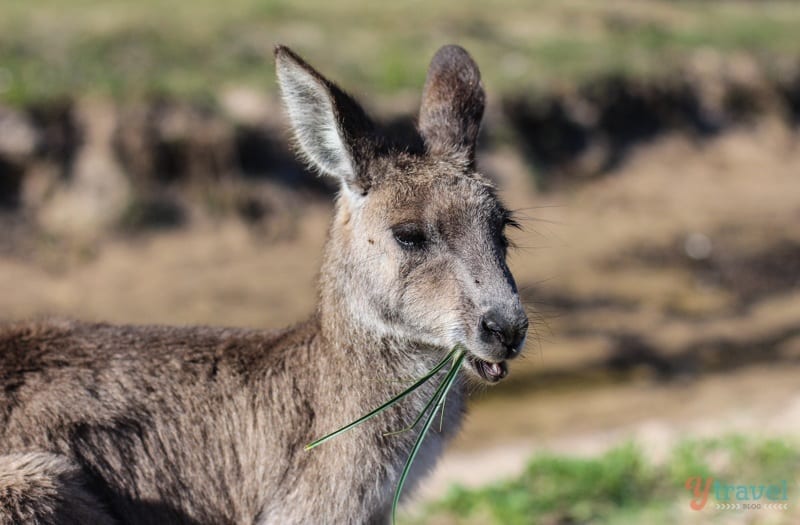
Despite what you see in movies, they are not as commonly found as you think. I think the first time I saw one in the wild was on Pebbly Beach in NSW when I was 19. And at Pebbly Beach, they graze on the grass like herds of sheep.
Could you imagine anything more iconic Australian? Kangaroos on the beach.
They are wild, yet they are so used to humans they allow you to come close without so much as an eye raise.
But if you’re not sure where to see wild kangaroos in Australia or where to start looking, here are all the best places to find them.
Can you find kangaroos anywhere in Australia?
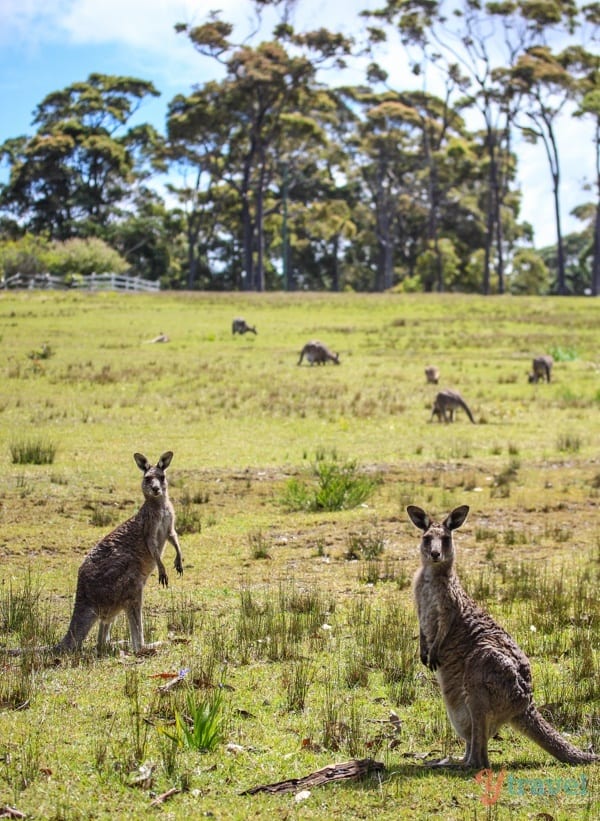
But first, can you find wild kangaroos anywhere in Aus? The answer is no. There are many different species of kangeroos, from rat kangeroos to gray kangeroos to Antilopine kangaroos.
The most popular species of kangaroo are the eastern gray, western gray, and red kangaroos.
The eastern gray kangeroo predominantly lives in Queensland and NSW on the East Coast, the western gray typically lives around South Australia, in Southwest Queensland, west New South Wales, west Victoria, and of course, Kangaroo Island (surprisingly we did not see many kangaroos on Kangaroo Island and NONE in Kangaroo Valley (but we saw lots of wombats).
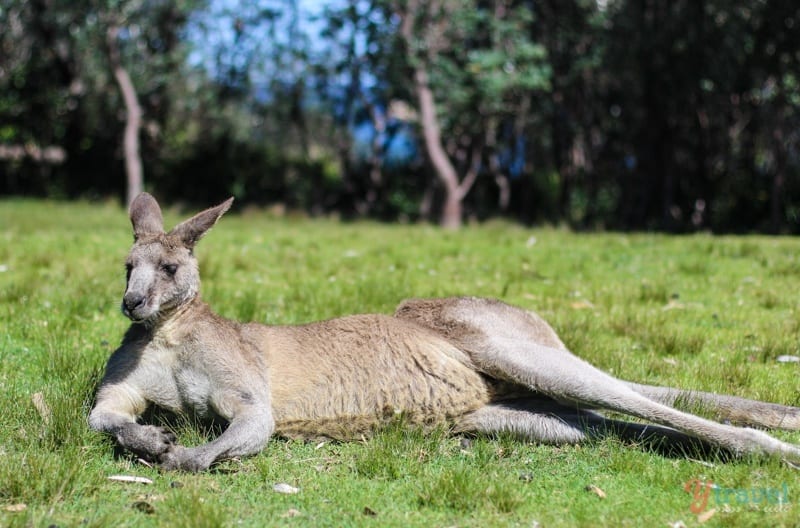
The red kangeroos are usually found in the outback.
They prefer to make their nests near rainforests or eucalytpus woodlands and graze on beaches, so you will usually find them in national parks away from human settlements.
The Best Places To See Wild Kangaroos in Australia
Now you know where you can go looking for wild kangaroos, here are some of the places we found to be the best places to spot them.
1. Murramarang National Park, New South Wales
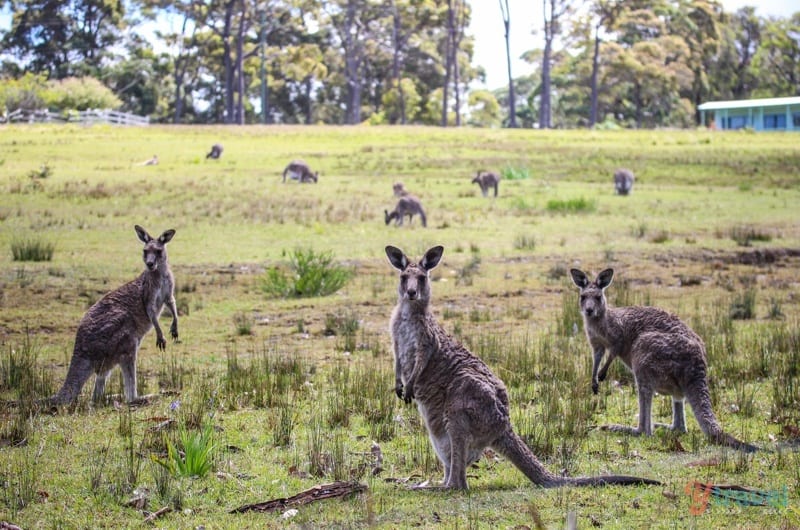
Over the three days we spent in the Murramarang National Park on the South Coast of NSW, Craig and I had many conversations about how we thought all tourists to Australia should now bypass Taronga Zoo in Sydney and just head a few hours south.
You’ll see kangaroos in the hundreds, wild and free. And I do mean that.
Upon arrival into the Murramarang National park, we came across a paddock in the middle of town near Merry Beach with so many kangaroos that we thought it must have been a kangaroo farm.
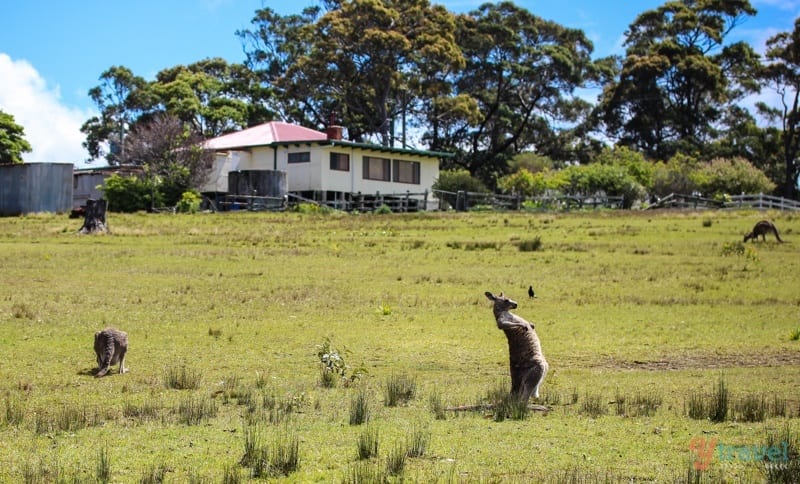
Pretty Beach
They were in people’s gardens, roaming the streets, lazing around on the side of bush walking trails, and hopping around the front of our cabin in Pretty Beach.
I was keen on camping at Pebbly Beach on this trip for my birthday. I felt a special connection when I first visited nearly 20 years ago with my family and wanted to return.
We ended up in a cabin at Pretty Beach, a little north from Pebbly.
It turned out to be just as special, maybe a little more so. The roos loved to chill outside our front porch.
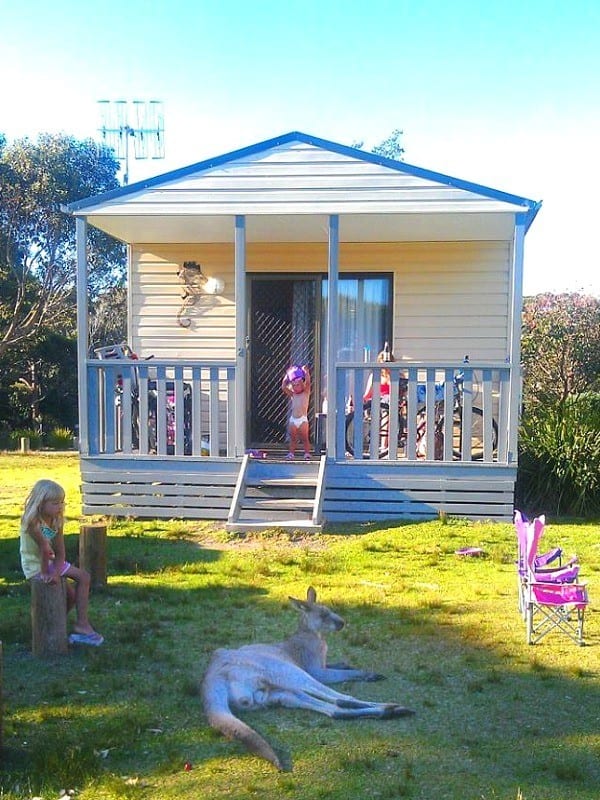
Every mumma had a baby just about, all snug in their pouches.
They stood around clapping and watching as the girls and Craig played Frisbee. They entertained Savannah as she sat in her chair watching them.
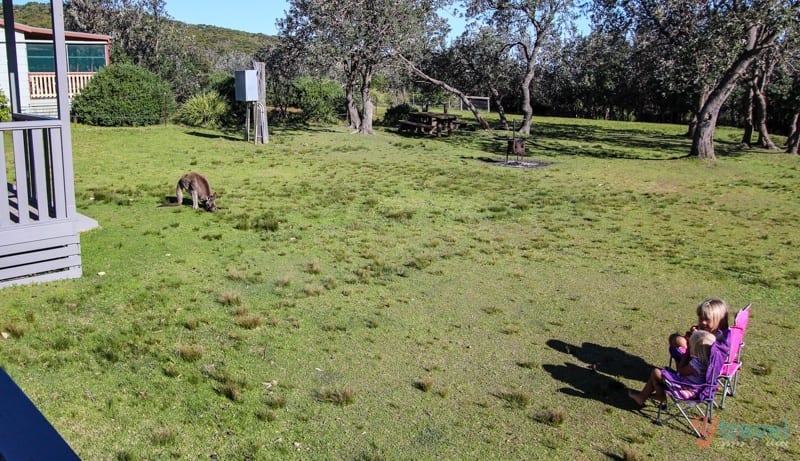
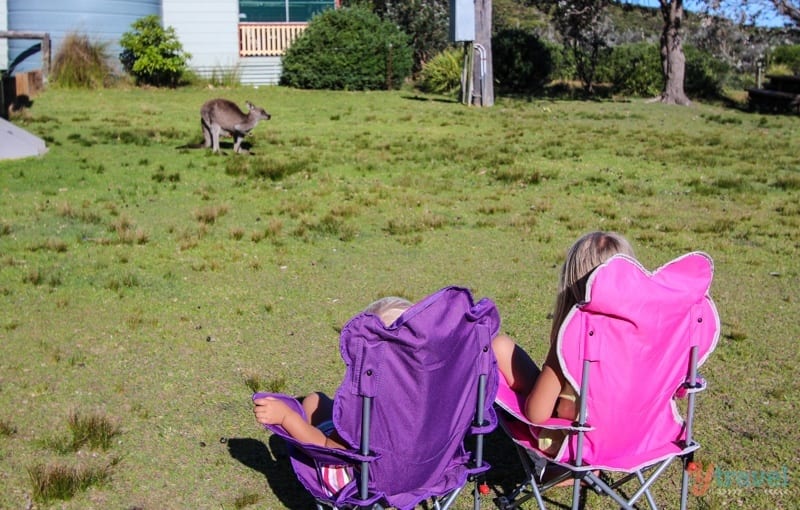
And they curiously gathered around me as I did my early morning yoga.
Just me, on the one patch of grass that had no roo poo, with magnificent views over the beach, a gentle morning breeze, and a crowd of kangas wondering what the hell a downward dog was.
Pure magic.
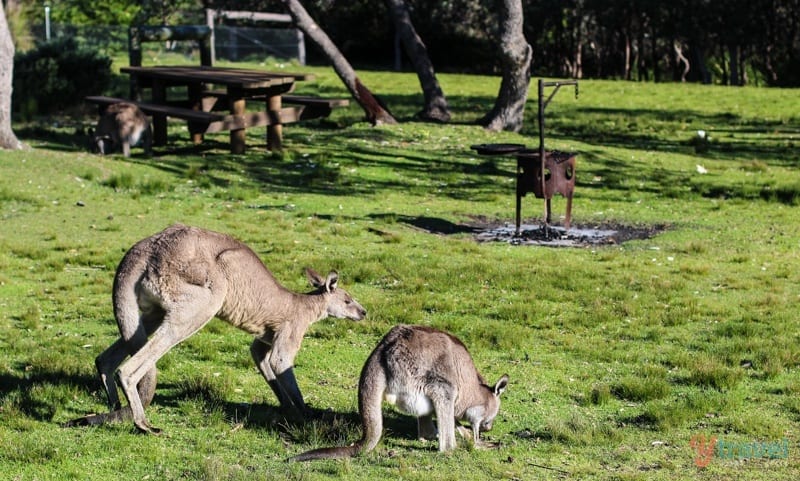
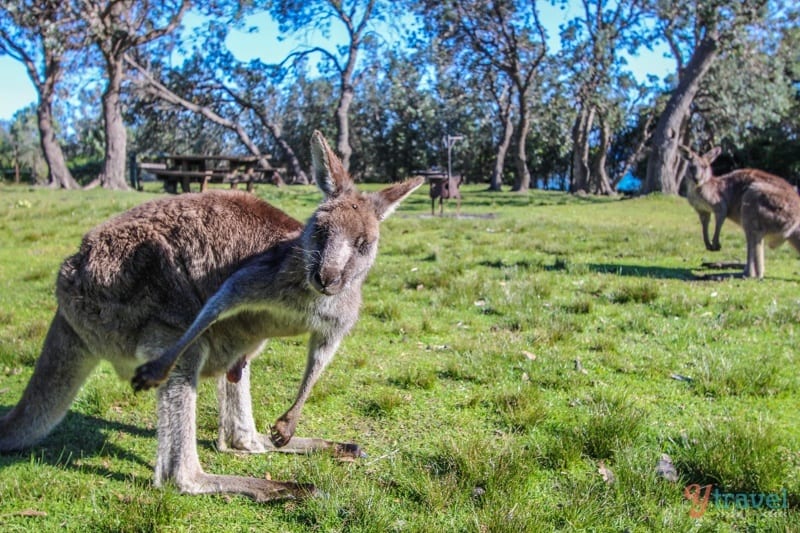
Another great place to see them near Pretty Beach was the bush walk from the campsite to the beach. We saw many grazing in the grass and hopping along the trail, showing us the way.
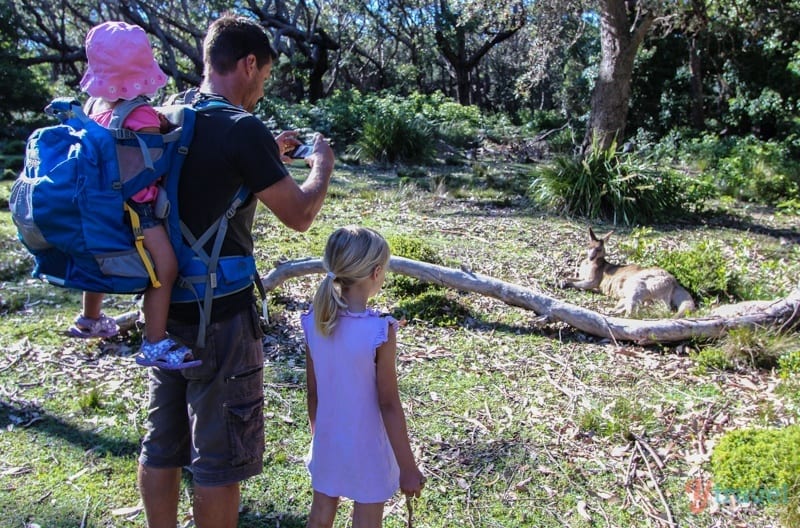
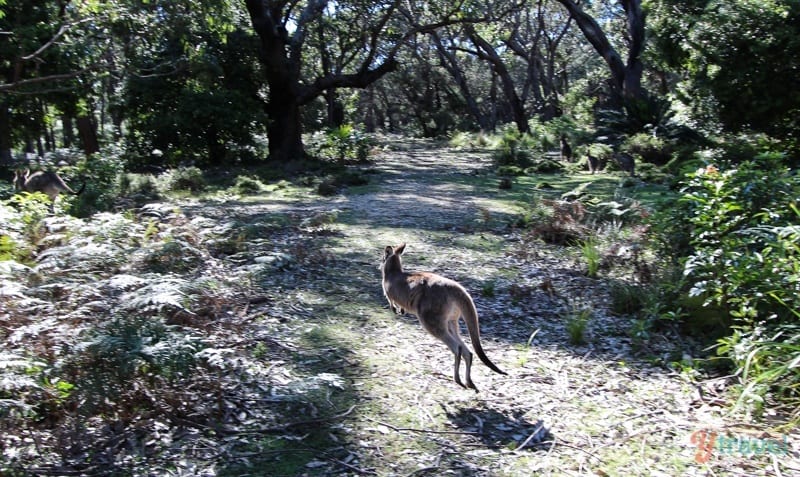
You can watch our video of the wild kangeroos playing near our cabin at pretty beach here.
Pebbly Beach
We then drove to Pebbly Beach, which is most famous for kangaroos on the beach, and found a group of kangaroos in the corner, near a crazy, protective bird that spent our entire visit swooping us.
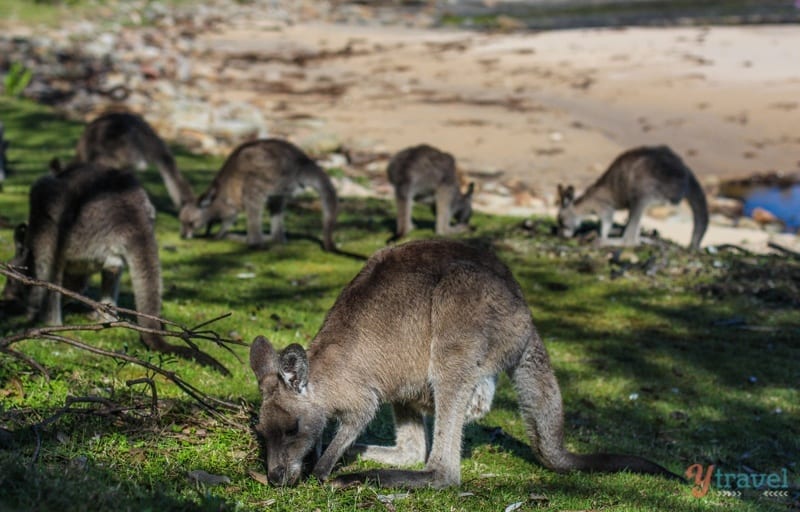
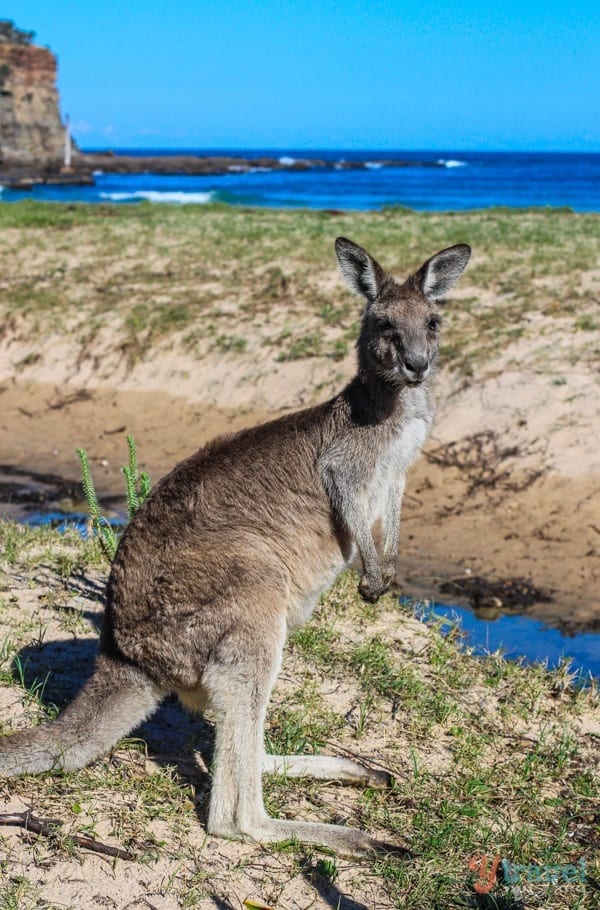
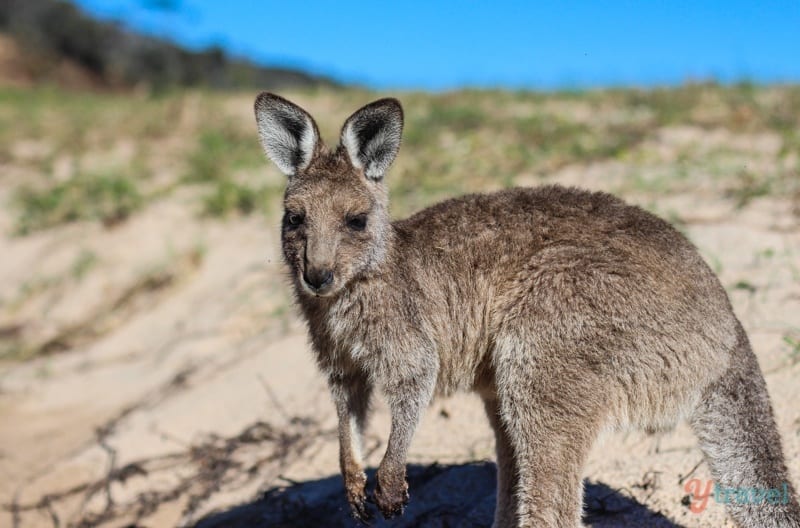
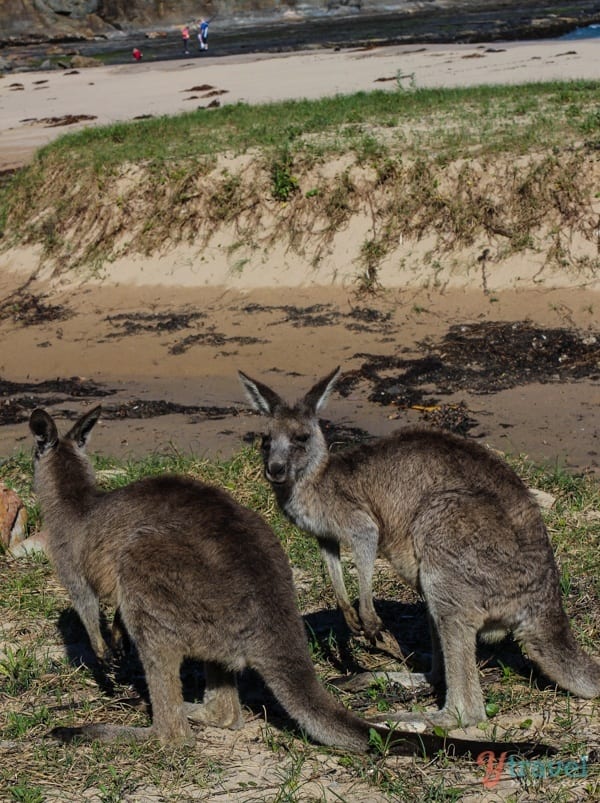
Depot Beach
We loved our discovery of Depot Beach, another place in the national park where you can see wild kangaroos.
You can camp here too. The girls enjoyed a little play in the rock pools, while even more kangaroos grazed and watched.
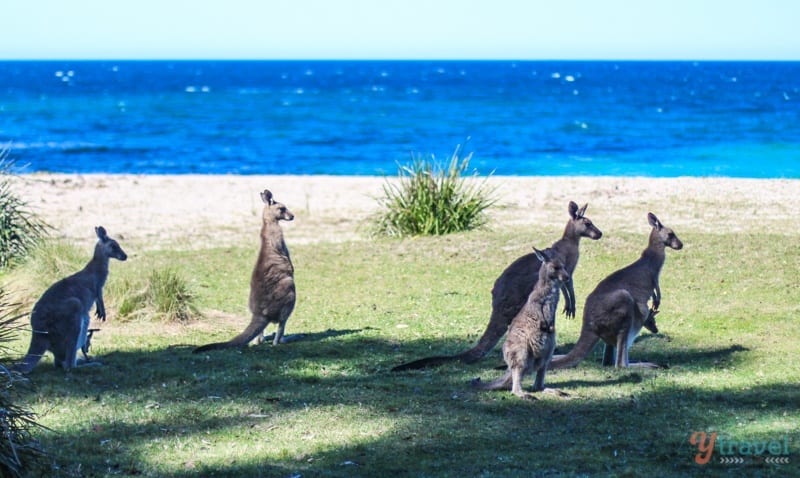
We found them chilling on the grassy area behind the beach and on the road near the carpark.
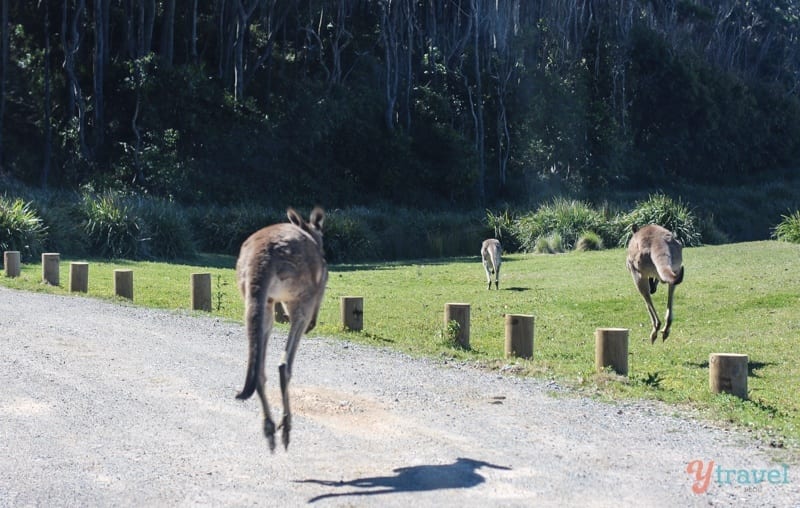
Getting to Murramarang National Park
Located on the NSW south coast only a few hours’ drive (250km) south from Sydney, Murramarang National Park spans 44km of coastline and has easily been the best place we have ever seen kangaroos in the wild.
We stayed in the Pretty Beach cabins thanks to Destination NSW. There are also plenty of walking trails, including rainforest trails, and hikes up nearby Mt Durras. And it’s one of the only places in Australia where spotted gums grow right down to the beaches.
There’s hardly another soul around, so you’ll have Australian natural beauty at its best for you to soak up.
If you want to see wild kangaroos in Australia, Murramarang National Park and its beaches is the place to go.
TOP ACCOMMODATION CHOICE: The stunning 4-star hotel, Pebbly Beach Escape, has sea views and is located within a few steps of Pebbly Beach and the kangaroos. See rates and availability here.
2. Mutitjulu waterhole, Uluru-Kata Tjuta National Park
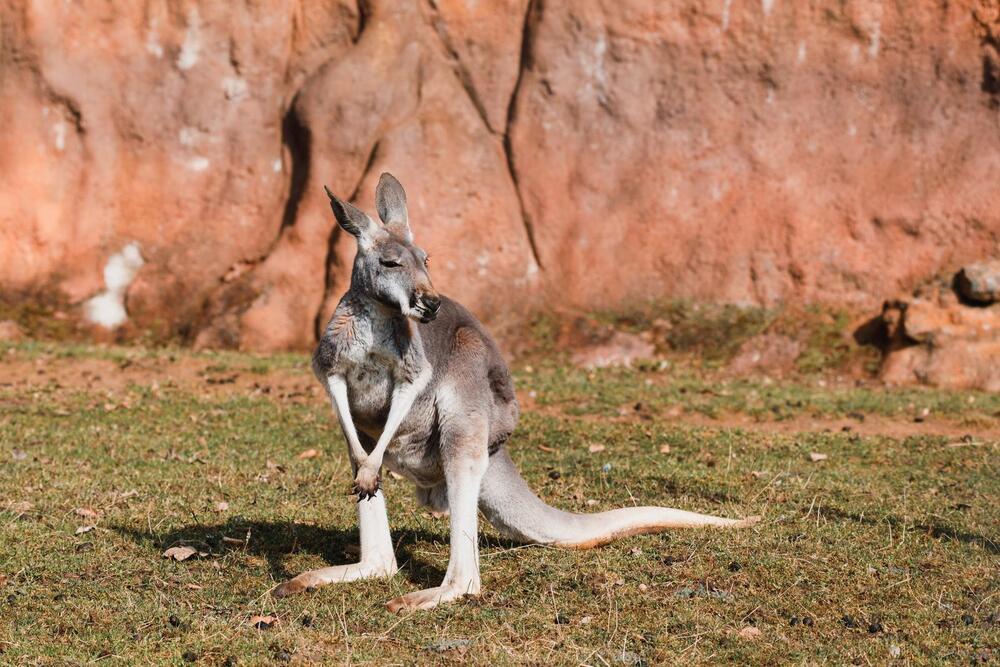
If you’re looking for red kangaroos in their natural habitat, then the best place to go is the Australian outback, specifically Uluru-Kata Tjuta National Park, the park home to the famous Ayres Rock.
One of the best places to see wild kangaroos in the park is by Mutitjulu waterhole, where kangaroos are often seen grazing in the grassland along the trail to the water.
The Kuniya Walk is where it’s especially common to see Red Kangaroos. The presence of water and the rocky red cliffs offering shade, provide a cooler spot for kangaroos to rest in.
Getting to Mutitjulu waterhole
Most people stay in Alice Springs when visiting the Outback, so from here you are going to want to rent a car and drive along the Stuart Hwy/A87 and State Route 4 south for around 4 hours.
If you want to make it a day trip, it will be a long day, but you can also camp nearby.
There is also a Kangaroo Sanctuary in Alice Springs where baby orphans are rescued, if you want to see more Roos. You can read more helpful tips on our guide to Uluru and Alice Springs.
TOP ACCOMMODATION CHOICE: You can’t go past a little luxury and celebrity treatment at the five star Sails in the Desert, just steps away from Uluru Lookout. The decor at Sails in the Desert is inspired by Aboriginal culture, and the hotel features original Aboriginal artworks throughout the public areas and in the guest rooms. The property features an outdoor swimming pool, a tennis court and a relaxing day spa. See rates and availability here.
3. Carnarvon Gorge National Park, Queensland

The best place in Australia for seeing wild kangaroos, has to be Carnarvon Gorge National Park in Queensland’s Sandstone Wildnerness.
We saw hundreds of kangaroos freely jumping around enjoying their spectacular home, as we did too, hiking and swimming in the creek. They happily joined us to swim or drink from the water.
In this Australian National Park, you’ll find deep, craggy gorges, jaw-dropping cliffs, and more than 2,000 pieces of aboriginal rock art. So it’s not just kangaroos to enjoy but a tropical oasis! Nestled amongst the rocks you’ll find mossy gardens and bright, emerald green plants and fauna.
Read our tips on things to do in Carnarvon Gorge with lots of photos of kangaroos!
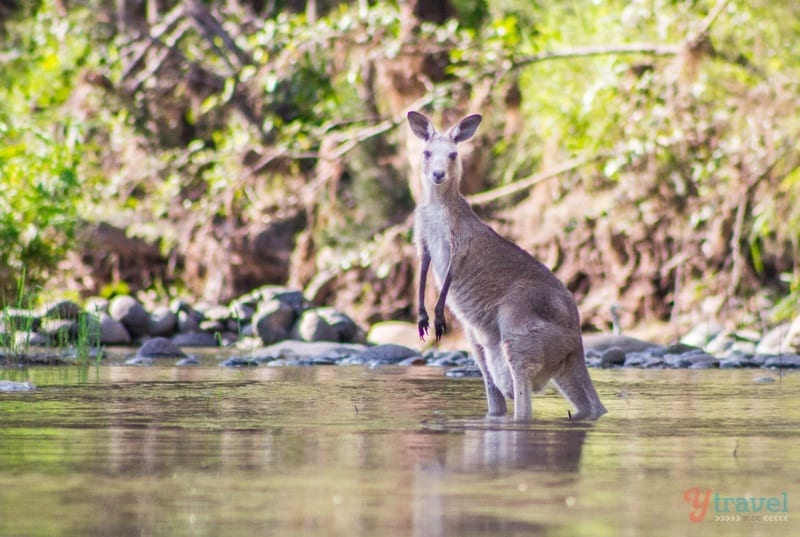
Getting to Carnarvon Gorge National Park
To get to Carnarvon Gorge you’re going to need a car, since it’s quite a trek and remote.
If you’re travelling from Brisbane, head 720km northwest via the Warrego Highway/A2 and Carnarvon Highway. The drive takes around 8 hours.
From Rockhampton, it’s 400km southwest via Capricorn Highway/A4 and Fitzroy Developmental Road/State Route 7, which takes about 4.5 hours.
We recommend you fill up your gas tank in Rolleston as there’s no petrol station in the park, and this is the nearest town.
We stayed at the Big4 Breeze Holiday Park just minutes away from the national park (with plenty of kangaroos jumping around) They have powered sites, cabins and cottages, safari tents, and non-powered sites. Check availability and prices here!
4. Cave Beach, Jervis Bay
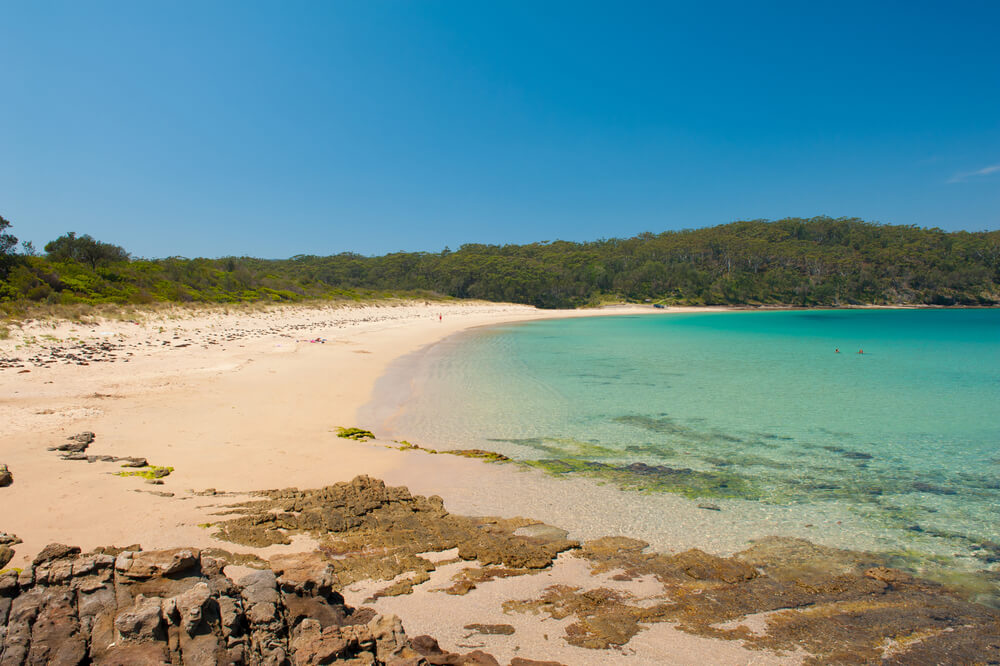
On the Pacific Highway South of Sydney you’ll find the small coastal town of Jervis Bay, which is famous for being a great place to do whale watching.
But while many keep their eyes on the ocean for dolphins and seals, those who head over to Cave Beach in the Booderee National Park will be met with a colony of happy wild gray kangeroos.
Cave Beach is not only a great place to see roos, but it’s also one of the most beautiful spots on the East Coast with pristine white sand and sea caves to explore.
Getting to Cave Beach
To get to Cave Beach, you need to head to the town of Jervis Bay, located 3 hours drive (195.2 km) south from Sydney.
From there, you should enter the Booderee National Park and follow the Cave Beach Road to the beach. You pass the botanical gardens along the way, and you will find parking at the beach.
5. Flinders Chase National Park, Kangaroo Island Wildlife Park
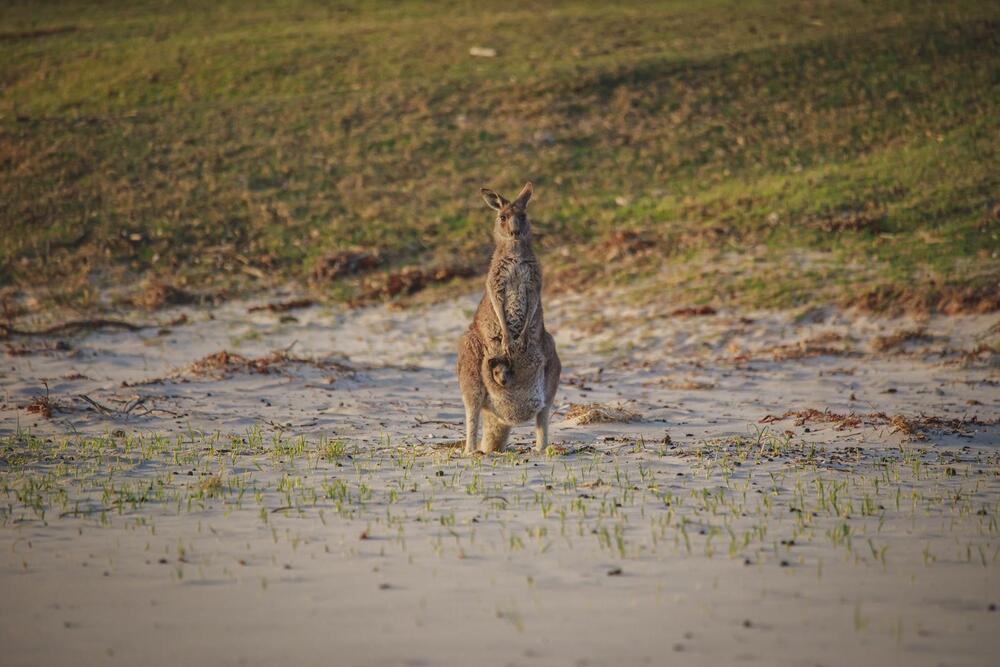
Kangaroo Island is probably the best place to see kangaroos and wallabies, since the whole island is a wildlife park dedicated to protecting Australia’s native animals.
You can also find wombats, emus, echidnas and lots of koalas.
The best place to see wild kangaroos on the island is in Flinders Chase National Park. This is one of the many conservation parks on the island and is made up of walking tracks through bushland, where wild kangaroos are known to hop around.
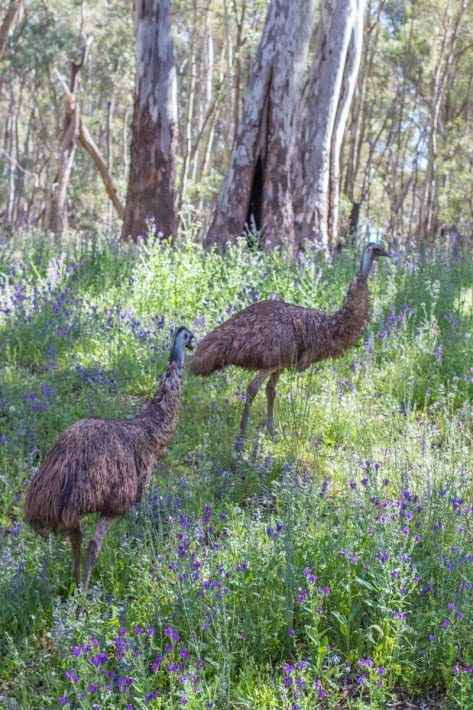
There is so much wildlife on Kangaroo Island, you won’t have to look hard to spot them. We visited for four days and loved the experience. You can read all our tips on Kangaroo Island, including the best winery view in Australia!
Getting to Kangaroo Island
You can take a day tour from Adelaide, which is a 45-minute ferry ride away from Kangaroo Island. This is the best way to see kangaroos and other wildlife since you will be escorted by a knowledgeable guide who knows the island well.
If you want to visit the island yourself, you can get the Kangaroo Island Ferry from Adelaide, or you can fly to Kangaroo Island Airport.
If you are driving along the Great Ocean Road, you will find ferries from Cape Jervis to Penneshaw on Kangaroo Island.
6. Narawntapu National Park, Tasmania
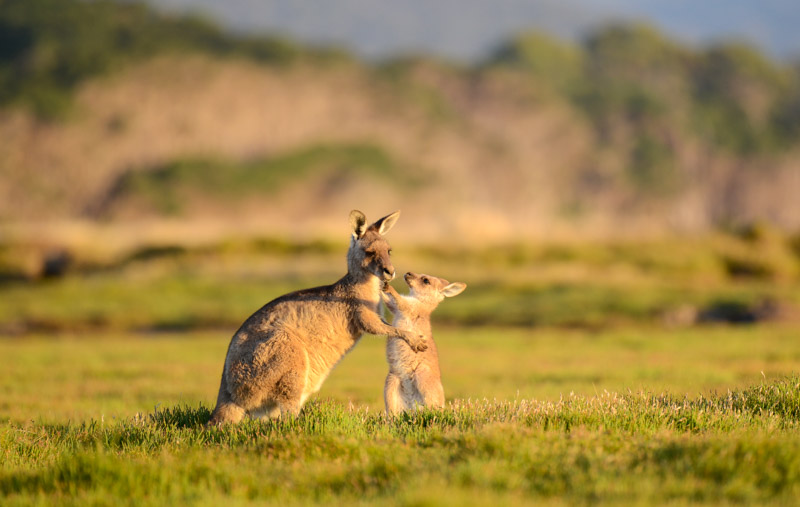
Tasmania is the largest island in the Australian territory and is well known for it’s great scenery and abundance of wildlife, such as Tasmanian Devils and Tasmanian Tiger.
It’s also possible to see penguins, emus and several other species of bird around Tasmania.
One of the best places to see wild kangaroos here though, is the Narawntapu National Park on the north coast of the island.
If you head to the visitor center in Springlawn, you’ll likely spot the island’s native Forester kangaroos, and wallabies grazing on the open grassland outside.
This is not only a great place to see kangaroos in their natural habitat, but you can also pick up information about the island’s hiking trails.
The landscape in Narawntapu is simply stunning, passing along coastal heathlands and dense woodlands, as well as past rivers, streams and waterfalls.
Getting to Narawntapu National Park
First, you must get to Tasmania, which you can get to by flight from Sydney or Melbourne to Launceston.
Once you have arrived in Tasmania, you can drive along the Tamar Rivers north to the Bass Strait. This is the entrance to the Narawntapu National Park.
7. Cape Hillsborough Beach, Mackay
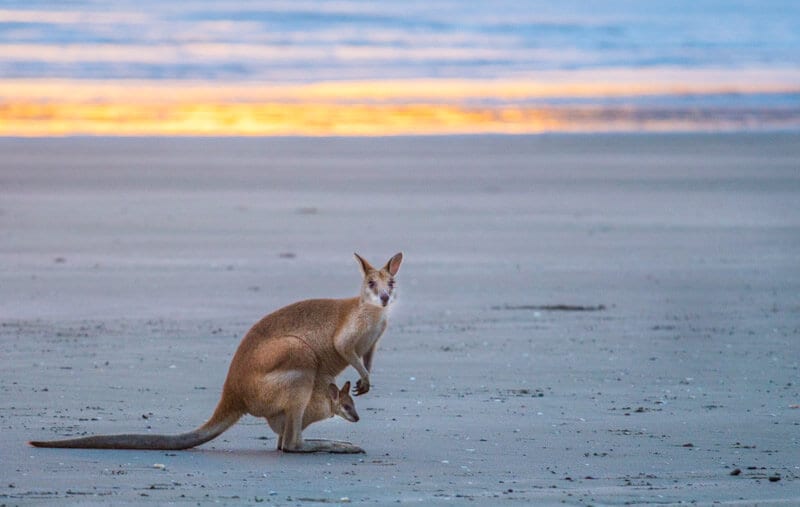
As soon as the sun begins to peak up from the horizon on this Queensland beach, wild kangaroos and wallabies come out to scour the morning tide for their breakfast of mangrove seed pods, seaweed, and coral sand dollars.
Sunrise at Cape Hillsborough Beach in Mackay is a very popular place to see kangaroos in the wild. The colors in the sky are just as mesmerizing.
As it’s in Tropical North Queensland, the kangaroos disappear not long after sunrise as the day warms up and they search for cooler ground.
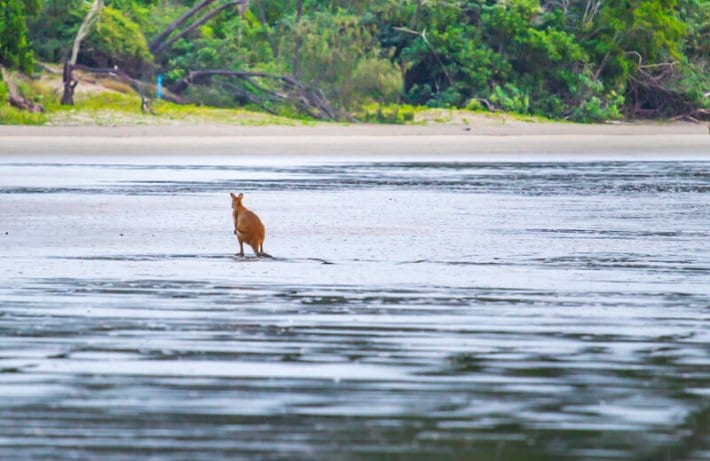
We did have some bounding around our cabin in the evening at the Cape Hillsborough tourist park though!
I recommend staying for a while as there are plenty of other fun things to do in Mackay, including see wild platypus at Eungella National Park, the only place in Australia where I have.
Getting to Cape Hillsborough Beach
Cape Hillsborough Beach is located in Cape Hillsborough National Park about 50km north-west town of Mackay in Far North Queensland.
From Mackay, travel north on the Bruce Highway for 20km and turn right into Seaforth Road. Travel a further 20km and turn right into Cape Hillsborough Road.
It will mean an early start if you are staying in Mackay. If you don’t want to drive it, there is a day trip from Mackay you can join for sunrise with the kangaroos and wallabies.
WHERE TO STAY: There are not many accommodation options in the national park. We stayed in a cabin at Cape Hillsborough tourist park which was just a short walk to the beach! Halliday Bay Resort is the next closest option at 6 miles away. offers self-contained villas with a private patio and lovely garden views, a golf course, restaurant and bar. See rates and availability here.
8. Lucky Bay, Esperance
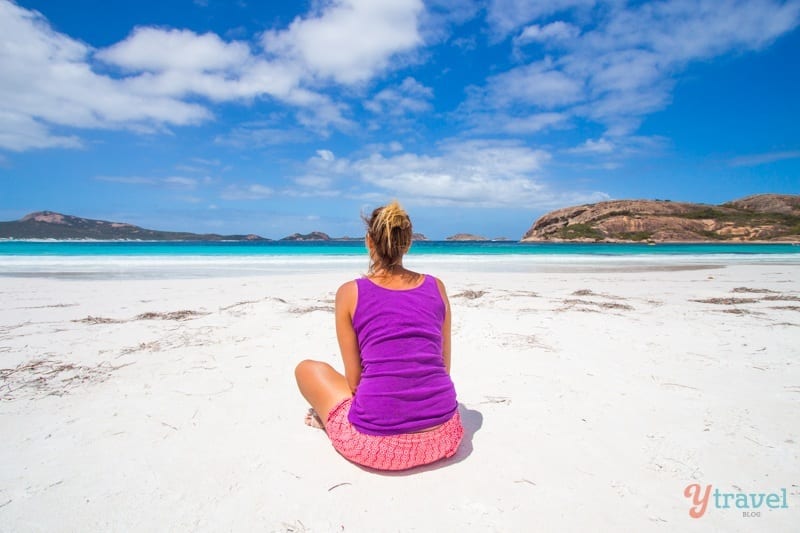
If you’ve seen photos of kangaroos on a white sandy beach with brilliant blue water, it’s more than likely Lucky Bay in Cape Le Grand National Park. It’s the place of many tourist’s dreams. It’s also remote and hard to get to. I’ve heard the kangaroos quite like that!!
One thing is certain, you will more than likely get distracted from the kangaroos by the stunning beach scenery.
It’s a really beautiful national park, but due to its remote location, it may not be worth such a long journey to get there, unless you are already traveling that way along the Nullabor, like we were.
I was more enamored with kangaroos in the wild in other locations that are easier to get to. We didn’t see all that many here and we didn’t even get a good photo. But this is definitely the most beautiful kangaroo home we saw!
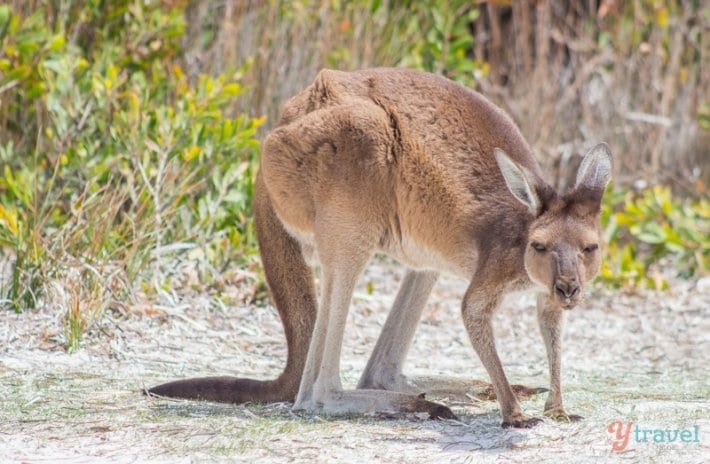
The water was very rough here and not great for swimming. The beaches in the Esperance area have strong currents and riptides, so always check with a local before you go swimming. Twilight Beach is meant to be the safest.
Getting to Lucky Bay

Esperance is the gateway to Cape Le Grand National Park, so you will first make your way there. Esperance is an eight-hour drive from Perth. See Rental car prices here.
Cape Le Grand National Park, which is just under 1 hour drive from Esperance.
Once you enter the National Park you will have to pay $15 entry fee per vehicle (unless camping). They take card and cash, but cash is generally easier if you have it on you. (Camping spots book out quickly!)
Once you’re in the national park, it’s 16km to Lucky Bay. You can drive your car on Lucky Bay! Be careful of the kangaroos.
This 6-Day tour from Perth will take you to Lucky Bay, stopping at many beautiful spots in Southwest Western Australia, including Margaret River (one of our favorite places in Australia) and the Albany region.
Final Thoughts on Where to Find Wild Kangaroos in Australia
Kangaroos are one of the most quirky and lovable animals in Australia but they love to keep to the forest, which makes spotting them in colonies a little difficult.
We hope this guide helped you plan a few highlights to add to your trip and gave you inspiration for wildlife spotting.
We hope you have an amazing time looking for wild kangaroos in Australia!
Other helpful Australia travel tips
[ad_2]
Source link
